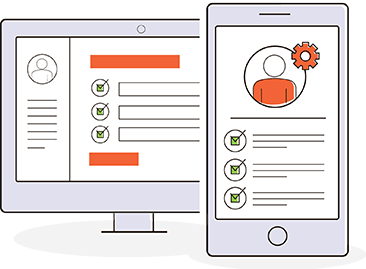Process Efficiency
Process Efficiency Can Be Improved with Process Automation

Process efficiency can be achieved through process improvement methods that cost-effectively increase throughput with the same or fewer resources and can be part of operational efficiency initiatives.
What Is Process Efficiency?
Process efficiency can be defined as the amount of effort required to achieve a business outcome.
A business result could be anything your company produces, whether it's a product (tangible or intangible) or the delivery of a service. Most companies produce products and services. For instance, even though Apple produces electronics, it has to service customers when there are issues. In both cases, Apple wants the processes involved to be as efficient as possible, delivering these outcomes, whether a cutting-edge laptop or a satisfied customer.
How Can Processes Be Made More Efficient?
Before a process can become more efficient, it must be fully understood. That means everyone involved in improving the process must understand the following:
- The primary business goal(s) the process is meant to achieve
- The constraints the process must operate within
- The strengths and weaknesses of the process in its current state
Once stakeholders understand and agree on these elements, strategies can be formed to keep the strengths while the weaknesses are eliminated.
Remember that efficiency is not a one-time effort and requires frequent evaluation and improvement. More on Process Improvement.
Benefits of Efficient Processes
The benefits of improved process workflow are numerous and go beyond the obvious "hard costs" of improved productivity.
Operational efficiency
Clear steps for all stakeholders in a process ensure time isn't wasted deciding or asking what needs to be done next. Automating tasks that are tedious and unnecessary for an individual to spend time on eliminates waste.
Consistent task execution
Predictable actions lead to predictable results. In variance cases, KPIs and audit tools can help diagnose where things went wrong and provide corrective action steps.
Actions are taken within the expected timeframes
Alerts, reminders, and escalation paths ensure that no one in the process misses a step within the allotted timeframe.
Improved profit margins
Higher productivity with the same resources in less time leads to improved returns. Get to market faster and hold off competitors with a well-oiled efficiency machine.
Better resource utilization
Staff can do more in less time and focus on higher-value activities that bring the organization more significant gains.
Better customer satisfaction
Turnaround time on customer requests and orders can be greatly reduced, and errors can be mitigated with consistent service delivery.
Reduced excess inventory
Clear business rules and reduced confusion in order processes lead to fewer order errors.
Efficiency Resources
To help you plan your strategy for making your processes more efficient, we've written several articles on the topic:
- What is a Process Audit?
- Document, Automate, Monitor: Getting Serious About Workflow Visibility
- Is it Time to Overhaul Your Processes?
- Business Process Optimization Fundamentals
- How to Build a Culture of Continuous Improvement
- For fun: How to Do 10 Things More Efficiently
How Does Process Automation Help Efficiency?
Process Automation contributes to process efficiency by using business rules and automated tasks to ensure process fidelity. Once a process is optimized theoretically, it must be put into practice. In some cases, this means providing standard operating procedures for each team member. In other cases, it means the process is built out within a process automation platform to automate the simple, rote parts of the process and keep things moving forward.
More Efficiency Resources
- Beyond Efficiency: Post-Automation Tips
- How Automated Procedures Improve Efficiency
- Overcoming Common Obstacles to Workplace Efficiency
- The Most Efficient Way to Do 10 Different Things
Interested in Process Efficiency?
We have a library of resources to help you on your journey to an automated purchasing workflow.


